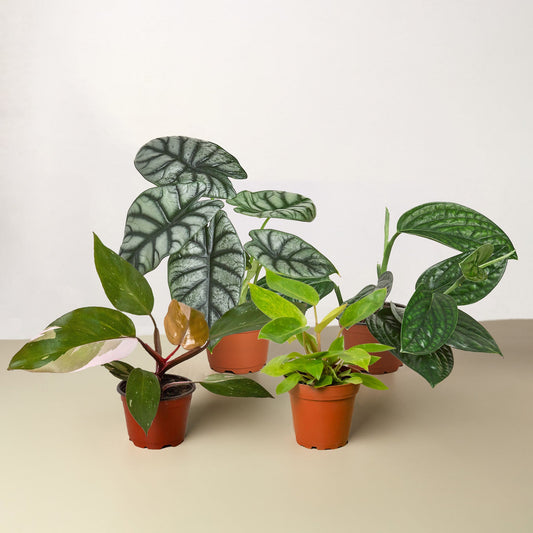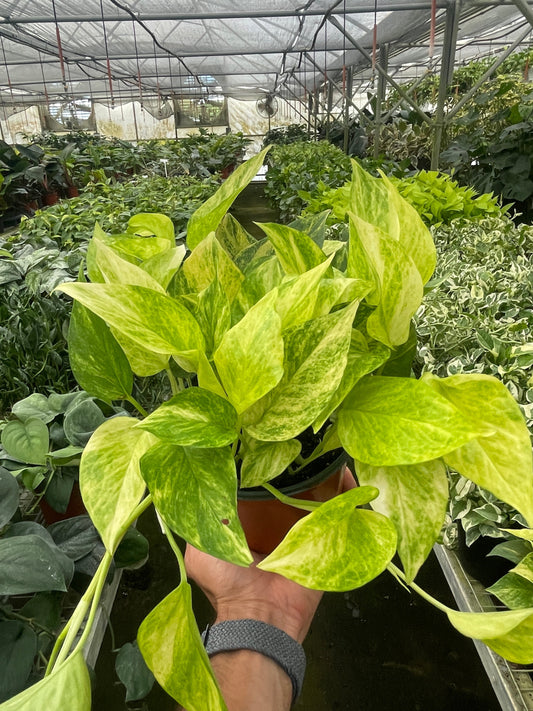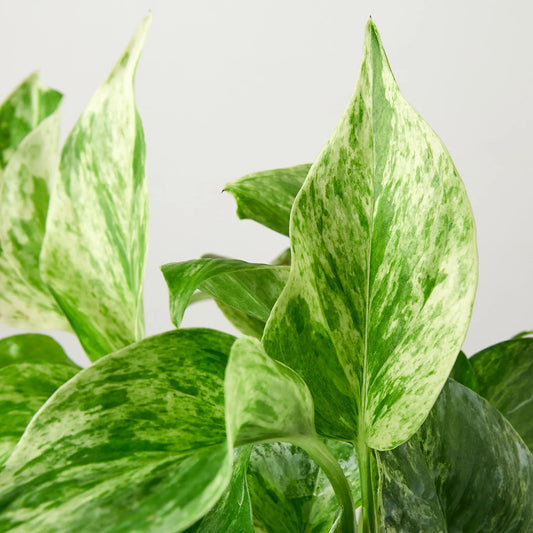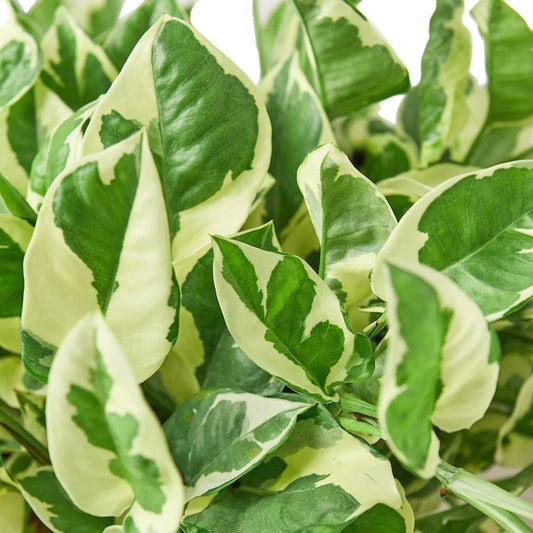Philodendron Mamei Aerial Roots: Everything You Need to Know
Cafe Planta Team
Philodendron Mamei has an enchanting presence that can turn any room into a mini rainforest. Its silver-patterned leaves and low-maintenance vibe make this plant a favorite among those who want a bit of nature indoors without too much fuss. But there's one part of this plant that often piques curiosity: its aerial roots.
In this article, we'll unravel the mystery surrounding Philodendron Mamei's aerial roots. We'll look into what they are, why they're important, and how you can use them to ensure your plant thrives. Whether you're a seasoned plant parent or just starting out, you'll find valuable insights to help you get the most from your Philodendron Mamei.
What Are Aerial Roots?
Before we get into the specifics of Philodendron Mamei, it's good to understand what aerial roots are. Simply put, they're roots that grow above the ground. Unlike the roots we typically think of that dig into the soil, these roots branch out into the air. But why do they do this?
In their natural habitat, many tropical plants, including Philodendron Mamei, use aerial roots to climb trees and absorb moisture from the air. It's a survival mechanism that helps them reach for sunlight and access nutrients they can't get from the soil alone. This climbing nature is part of what makes Philodendrons such versatile houseplants.
For Philodendron Mamei, these aerial roots can be a game changer. They allow the plant to anchor itself to a surface, like a moss pole, and grow upwards. This can be especially useful if you're short on space and want to make a vertical garden. You might also notice that these roots are thicker and sturdier than typical roots, designed to grab onto surfaces securely.
For those new to plant care, aerial roots can seem a bit alien. But once you understand their purpose, you'll see them as a unique feature that, with the right care, can enhance your plant's growth and health.
Why Does Philodendron Mamei Have Aerial Roots?
Philodendron Mamei has aerial roots for a few key reasons. First and foremost, they're all about support. In the wild, this plant often grows in tropical environments where it climbs trees to reach sunlight. The aerial roots help it cling to tree trunks, which isn't just about stability—it's a strategic move to get more light.
Another reason these roots exist is moisture absorption. In humid environments, aerial roots can absorb water directly from the air. This is why you might notice that your Philodendron seems to thrive in a room with consistent humidity. These roots are working overtime to soak up that extra moisture, giving your plant a little boost.
Aerial roots also play a role in nutrient gathering. Since they're exposed to the air, they can absorb nutrients that aren't available in the soil. This can be particularly beneficial if the plant is growing in a pot where nutrients might become depleted over time.
These roots are not just a quirk of nature—they serve important functions that help the Philodendron Mamei thrive. Understanding this can help you better care for your plant, ensuring it remains healthy and vibrant.
Should You Trim Aerial Roots?
Now that we've covered why aerial roots are important, you might wonder if you should trim them. The short answer is: it's up to you, but it's generally not necessary.
In most cases, leaving aerial roots alone is best. They don't harm the plant, and trimming them won't necessarily make your plant healthier. However, if they're becoming a bit unruly or unsightly for your aesthetic, trimming them is an option.
If you decide to trim, do so carefully. Use clean, sharp scissors or pruning shears to make a clean cut. This reduces the risk of infection or damage to the plant. Remember, these roots are part of the plant's natural growth, so removing them won't stop the plant from growing new ones.
On the other hand, if you want to give your plant the best chance to grow and climb, consider leaving those roots as they are. You can even encourage them to latch onto a moss pole or trellis, helping your Philodendron climb and create a lush, vertical display.
How to Use Aerial Roots for Climbing
If you're looking to make the most of those aerial roots, using them for climbing is a fantastic idea. This not only benefits the plant but can also add an interesting vertical element to your home decor.
Here's how you can encourage your Philodendron Mamei to climb:
- Install a support structure: A moss pole or trellis is perfect for this. They mimic the natural tree trunks that Philodendron Mamei would climb in the wild.
- Position the plant close: Place your plant near the support structure and gently guide the aerial roots to attach.
- Use ties if necessary: If the roots aren't easily attaching, you can use plant ties to secure the stem to the support. Be gentle and don't tie too tightly.
- Maintain humidity: Since aerial roots absorb moisture, keeping the humidity level up can encourage growth. A humidifier or regular misting can help.
This method isn't just for aesthetics. Climbing helps the plant reach for more sunlight, which can lead to healthier growth. Plus, it makes for a dynamic display in your home, adding layers and depth to your plant collection.
Watering Considerations for Aerial Roots
While aerial roots are great at absorbing moisture from the air, they still need a bit of help when it comes to watering. Ensuring your Philodendron Mamei gets the right amount of water is crucial for its overall health.
Interestingly, the presence of aerial roots can be a useful indicator of your plant's watering needs:
- Check the soil moisture: Use your finger to test the top inch of soil. If it feels dry, it's time to water.
- Observe the aerial roots: If they seem to be drying out or looking a bit shriveled, your plant might benefit from higher humidity or more frequent watering.
- Don't overwater: While aerial roots enjoy moisture, the soil should never be waterlogged. Ensure your pot has good drainage.
Remember, aerial roots are just one part of the plant's water system. They work in conjunction with the soil roots to keep your Philodendron Mamei hydrated. Balancing these needs can go a long way in promoting vigorous growth.
Humidity and Aerial Roots
As we've touched on, aerial roots of the Philodendron Mamei thrive in humid conditions. They can absorb moisture from the air, which helps keep the plant healthy and vibrant. But what if your home isn't naturally humid?
Here are some tips for increasing humidity around your plant:
- Use a humidifier: This is the most effective way to raise humidity levels, especially during dry months.
- Mist the plant: A simple spray bottle can add a bit of extra moisture. Just be careful not to overdo it, as too much water can encourage mold or mildew.
- Create a pebble tray: Place a shallow tray filled with water and pebbles under the plant. As the water evaporates, it increases the humidity around the plant.
Boosting humidity not only benefits the aerial roots but also the entire plant, promoting lush growth and preventing the leaves from drying out or browning.
Repotting Considerations
Repotting a Philodendron Mamei involves more than just changing its pot. You also need to consider its aerial roots. These roots can be fragile, so take care during the repotting process.
Here’s a step-by-step guide to repotting your Philodendron Mamei:
- Choose the right pot: Select a pot that is slightly larger than the current one. This gives the roots space to grow.
- Prepare fresh soil: A well-draining potting mix is crucial. You can add perlite or orchid bark to improve drainage.
- Handle with care: Gently remove the plant from its current pot, being mindful of the aerial roots. If they're attached to a support, work slowly to free them.
- Position the plant: Place the plant in the new pot, ensuring the aerial roots are not buried. They should remain above the soil line.
- Water well: After repotting, give the plant a good watering to help it settle into its new home.
Repotting offers a fresh start for your plant, allowing it to access new nutrients and space to grow. Just remember to be gentle with those aerial roots!
Common Mistakes with Aerial Roots
Caring for Philodendron Mamei’s aerial roots might seem daunting at first, but it's all about avoiding a few common pitfalls. Many plant parents make mistakes with these roots simply because they don’t understand their role.
Here are some common mistakes to avoid:
- Ignoring them: Some people think aerial roots are unsightly and choose to ignore them altogether. Remember, they serve important functions.
- Over-trimming: While it's okay to trim aerial roots for aesthetics, excessive trimming can hinder the plant's ability to climb and access moisture.
- Improper humidity: Aerial roots need humidity to thrive. If your home is too dry, consider using a humidifier or misting regularly.
By understanding the purpose and needs of aerial roots, you can avoid these mistakes and create an environment where your Philodendron Mamei can flourish.
Using Aerial Roots in Plant Decor
Aerial roots aren’t just functional—they can also add a unique aesthetic to your home decor. Their presence gives your plant a wild, natural look that can complement various styles, from boho to modern.
Here are some decor ideas using aerial roots:
- Vertical gardens: Use aerial roots to help your Philodendron climb a trellis or wall, creating a living tapestry.
- Hanging displays: Suspend your plant in a hanging basket, allowing the aerial roots to cascade over the sides.
- Styling with other plants: Combine your Philodendron with other plants that have similar needs, creating a lush, layered look.
Incorporating aerial roots into your decor not only highlights their natural beauty but also creates a dynamic, eye-catching focal point in your space.
Final Thoughts
Philodendron Mamei’s aerial roots are more than just a quirky feature—they’re an essential part of the plant's growth and health. By understanding their role and needs, you can enhance the beauty and vitality of your plant.
At Cafe Planta, we love sharing our passion for plants. Whether you're looking for new additions to your collection or need expert advice, we're here to help. Feel free to email us with your questions or connect with us on Instagram. We believe plants can bring us closer to nature and each other, and we're excited to help you create a thriving indoor garden.



















